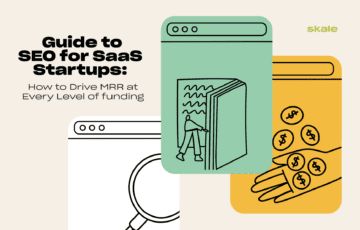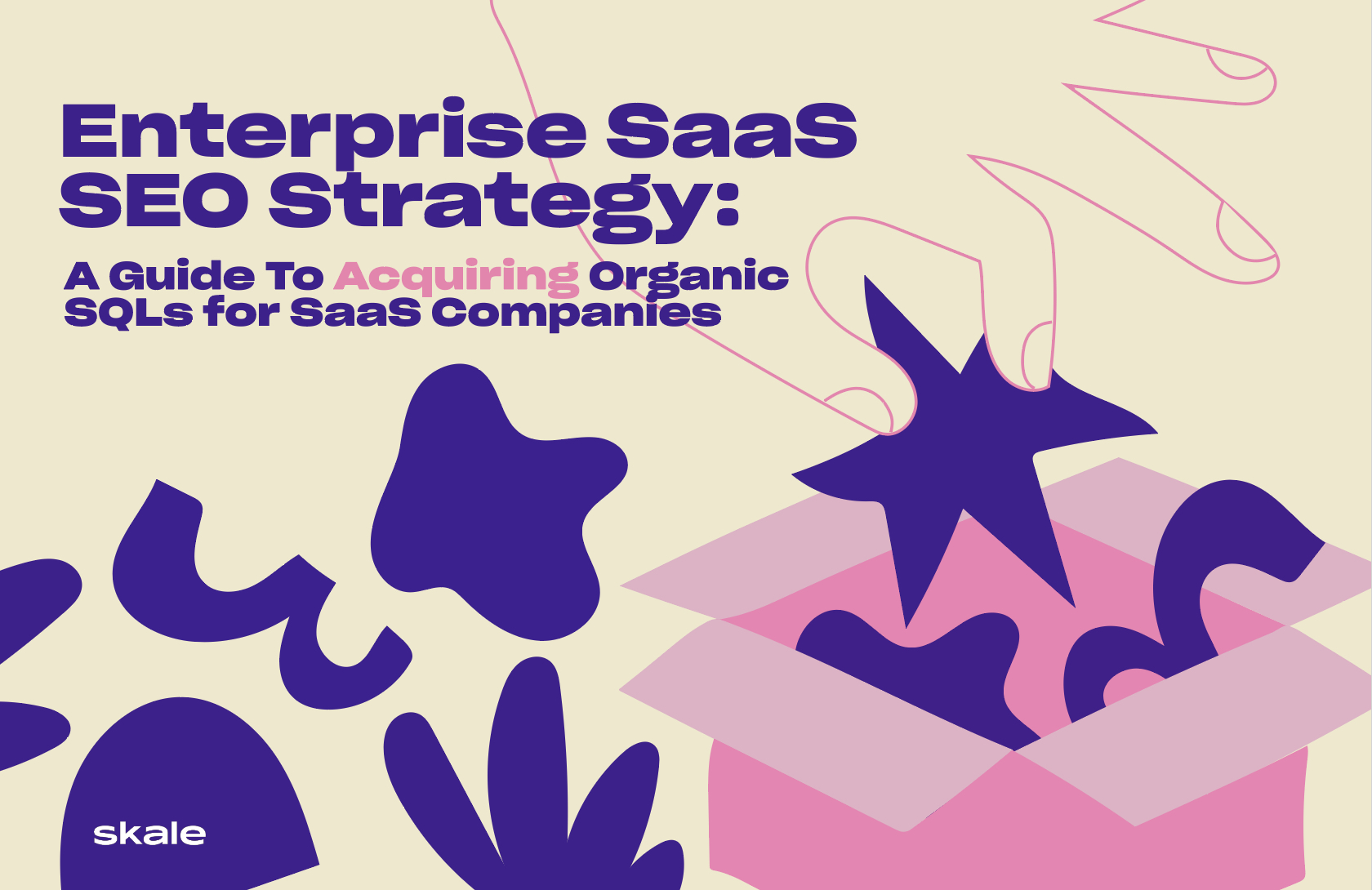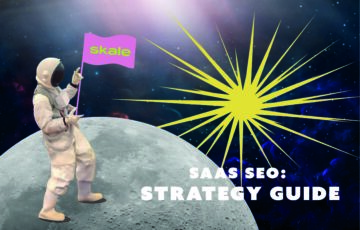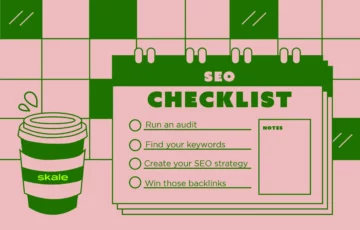
Guide to SEO for SaaS Startups: How to Drive MRR at Every Level of Funding
Discover how to drive MRR with SEO for SaaS startups, and how your B2B SEO strategy should evolve for different levels of business funding.

Picture this: you’re at the helm of a thriving SaaS enterprise where most of your audience depends heavily on Google searches to guide their decisions.
Your mission? To dominate those search results and convert high-quality leads into customers.
Welcome to enterprise SaaS SEO. This isn’t just a pass to more online visibility and generic clicks from everyone and their mother, it’s your golden ticket opportunity to nurture prospective customers seeking the solutions only an enterprise like yours can provide.
We’ve gathered the great, mixed in some of our own, and have curated your guide to acquiring more organic SQLs for enterprises just like yours. Comfy? Your journey starts here.
For enterprise SaaS brands, SEO challenges are amplified by the scale of operations, the intensity of the competition, and the complexity of offers and solutions these large SaaS businesses have. This makes enterprise SaaS SEO require a more tactical approach than traditional SEO and calls for a continued holistic overview.
Jason Wise, Editor at EarthWeb, shared the top three differences that make enterprise SaaS SEO particularly challenging compared to traditional — smaller-scale–SEO:
1. Search engines struggle to crawl and index millions of website pages for a large SaaS company. It’s also difficult for smaller teams to monitor all web pages and optimize them for SEO.
2. The constant change in SaaS solutions can be confusing. Maintaining the company’s website’s keyword alignment and adapting to SEO trends is a continuous cycle.
3. The fierce rivalry from other SaaS providers for keywords complicates matters. Even with significant SEO spending, ranking high in search results is difficult in today’s congested SaaS industry if you’re not going all in.
In smaller-sized companies, SEO decisions can be made much quicker, there are fewer stakeholders at play. This is helpful since Google’s algorithms and audience needs are constantly changing, and smaller teams can be more responsive to a change in the market.
However, enterprise-level companies can face internal alignment issues and slower decision-making due to their size and product messaging stakeholders: you’ve got product, marketing, communications, sales, customer success, so many teams often needing to have a say in language and strategy. This can negatively affect enterprise SEO agility.
Although some SEO principles are the same for small and large businesses, the intricacies of enterprises make enterprise SaaS SEO a more lucrative beast to tame.
First off, let’s tackle why investing time, effort, and resources in SEO is worthwhile for your SaaS enterprise:
The bottom line? These benefits aren’t just pointers on a presentation slide, they’re the building blocks of more organic SQLs and measurable KPIs. The gold standard of enterprise SEO isn’t just growth — it’s sustained, targeted, and measurable growth. Music to your investors’ ears.
We spoke to Peter Michaels, CEO of Yeespy, who explained every challenge that comes with enterprise SEO can also be turned into an opportunity:
“The main challenges of SEO for enterprise SaaS companies include high keyword competition, complex websites that make technical SEO difficult, content saturation, rapidly changing product features, and a longer sales cycle.
For example, at Yeespy, we target a global audience, making our SEO strategy more complex However, this challenge is an opportunity for growth and resilience. By understanding the unique aspects of SaaS SEO and focusing on strategies that generate top-quality SQLs, we improve our online reputation and revenue.”
SEO for larger enterprises requires a herculean effort — given the sheer amount of elements in play. The complexity and scale of operations bring gigantic challenges, but they can also bring gigantic rewards. Here are some of the top strategies we use here at Skale:
Before diving in, let’s establish your compass — your keywords. They guide your content creation and heavily influence your ranking potential. Keyword research can be broken down into two elements.
Start by understanding who you want to reach. Work closely with sales teams to pinpoint your ideal persona for their contract value or lifetime. From there, you can conduct interviews with these people to identify their jobs-to-be-done, previous ways of doing things, blockers to buying, competitor knowledge, and their thought process for searching for a solution online.
Once you’ve conducted these moderated interviews — as surveys just aren’t going to give you the same level of qualitative insight you need — you’ll be able to do the following:
A thorough competitor analysis is a must for a solid enterprise SEO strategy. Many of our clients in the past have been at a loss on where they should begin with a competitor analysis, so here’s how we run things:
With your keyword research as informed as it can be, it’s time to delve into your content build, which is going to look a little different if you’ve done SEO on a smaller scale before. Here are a few top tips from the Skale team:
Identify renowned experts who align with your enterprise’s vision and can contribute valuable insights. Include their input in your blog posts, videos, podcasts, or webinars.
The association with an industry expert not only strengthens your content’s authority but also creates crossover audience engagement. Ensure that the contribution of these experts is highlighted through various promotional strategies of your content (newsletters, social media, etc) to maximize reach and align your brand with those you want to be aligned with.
Building content based on real stories is the most sure-fire way you can ensure your articles are wholly unique, and stand out against that 101 content that’s been on top for too long.
Dominate brand mentions
During each customer journey, potential customers will get to a point where they will start comparing the alternatives on the market. This means they’ll likely be Googling you and other brands, something that’s always going to happen despite AI, as they’ll be looking for real-world opinions and the most recent reviews on all the SaaS available.
It’s your job to dominate the ranks when it comes to your branded keywords and ensure you’re in control of the narrative around your brand. It’s not uncommon for competitors to do potentially misleading comparison pages, although this is frowned upon by many it still happens. So, you’ll want to be on top of your own brand name, and ensure you’re giving a true account of what your SaaS can achieve.
Answer multiple decision-makers’ queries
Ensuring you’re optimizing your content to answer all decision-makers’ questions is a big must for enterprise SEO. There’s a high chance you’re not just writing for a founder, which is often the case if you’re targeting SMBs. In this case, you’re writing for a Head of, Director, Manager, the role that’s actually going to use your tool (your in-house ambassador) and potentially someone from the Finance department too.
Although this doesn’t mean you need to tailor your style and JTBD examples for every persona, you will need to answer each specific role’s questions and overcome their barriers to buy naturally throughout the piece. Many businesses choose to do this with FAQs, but conversion will be more effective if you meet readers sooner and highlight specific pain points in headings.
As you probably know, the digital footprint of your SaaS extends beyond the confines of your website. Off-page SEO and link-building strategies hold one of the many keys to bolstering your site’s performance. Here’s what you need to know.
An oldie, but a goldie, and often forgotten. If you’re at enterprise level then there’s a huge chance your brand is being talked about in the big bad web. The strategy here is simple but might require some legwork: seek out those brand mentions and convert them into backlinks.
Use tools like Google Alerts or Mention to keep track of when and where your brand is being discussed. When you find brand mentions, reach out to the website owner or author and request a backlink.
Note: you’ll only want to be doing this where there’s a positive framing around your brand. Unfortunately, there’s also a chance your brand is being mentioned in a negative light. So, get the context of the article before you reach out.
If you want to take this strategy up a notch, then consider an anchor text framework and a specific page link of a page you’re trying to build. For example, rather than us just asking a brand mention to hyperlink Skale to our homepage, we may ask them to hyperlink Skale’s epic guide to enterprise SaaS SEO and link right here.
Leverage review sites
Embrace review opportunities on sites like G2, Capterra, and Trustpilot. Any SaaS buying stakeholder is going to do their research before investing in your product, and they’re going to be going to a 3rd party platform to avoid as much bias as possible.
G2 found that 94% of buyers have used a review site to help them make a SaaS purchasing decision. That is a huge amount of your market share that will be doing their research on your product off of your website. Although these platforms rarely share a “do-follow” link, getting positive reviews on these sites will massively influence your buyers’ purchasing decisions.
Publish press releases
Press releases are a gold mine for SQLs, and can have your brand not only win quality back-links but get in front of new markets under different content angles. They’re great for problem-aware buyers.
For this one, we’ll give the mic to Riva Jeane May Caburog, PR/Media Coordinator at Nadrich & Cohen:
“Leveraging the power of press releases in your SEO efforts can help you attract high-quality SQLs. That is, if instead of using press releases to deliver bland self-promotion, you use them as a medium to share stories that personally connect with your audience. Share anecdotes of businesses that have benefited from your SaaS solution, and offer insights into industry trends your software addresses. This turns your press releases into useful resources that are relatable to people facing real challenges.
Ensure that your press releases are distributed through trusted, industry-specific platforms. This way, you can reach the right audience who are actively seeking solutions like yours. Once your press releases become an integral part of your SEO strategy, they can eventually increase your brand visibility and attract more potential SQLs as they find relevance and value in your content.”
To bring it all together, we have technical SEO—the foundation of your SEO strategy. There are a few things you need to consider for this one, so now may be the perfect opportunity to top up that cup of coffee.
Site structure is akin to a blueprint of your enterprise. A well-planned, logical site structure aids search engines in understanding and indexing your website efficiently, and of course, provides for a more logical-feeling UX.
Begin by conducting a comprehensive audit of your current site structure to identify areas that need tweaking. Develop a visual sitemap that portrays your website’s architecture, and run card sorting tests with site users to see if your information structure has the most logical flow for your browsers. This also enables you to spot any inconsistencies, disconnects, or redundancies and get them all sorted to enhance user experience and crawlability.
Pay special attention to elements like nesting, hierarchy, and website depth while designing your structure. Draven tells us more.
“Your internal linking structure helps Google understand your website’s hierarchy and how the different pages relate to each other. This has made me realize how important it is to link to related pages from within your own material. Using appropriate anchor text for these links is like putting up signs to help people and search engines find their way around your site, making it easier to navigate overall.”
— Draven McConville, CEO & Founder at Klipboard.
SEO automation comes in many forms, including site crawlers, tools for image optimization, and plugins for internal linking. Identify and integrate tools based on your specific requirements.
Some popular tools include MozPro, Yoast SEO, and Screaming Frog SEO Spider, among others. These tools can automate repetitive tasks and provide insights along the way, giving you more time to focus on other strategic initiatives that need human input. Having an effective and struggle-free process to automate and optimize the many pages that enterprises have is key to success.
Avoid cannibalization!
Cannibalization is a phenomenon that can happen to all-size websites, but it happens more often in websites with many, many pages — like those from enterprises, that’s you! Keyword cannibalization is when multiple pages on a website compete for the same keyword, leading to a drop in search engine rankings and traffic for those pages. Suraj tells us more.
“When trying to rank for numerous keywords, some pages may inadvertently target the same terms. This leads to keyword cannibalization, diluting your site’s SEO strength. An example is a SaaS company having multiple product pages with similar content. Streamlining content and strategic interlinking can help mitigate this issue and boost overall SEO effectiveness.”
— Suraj Nair, Marketing Department at SocialPilot
Making sure that this is not happening to your website will give all of your keywords a fighting chance while ensuring they’re not competing against each other.
Cannibalization happens most with overwhelmed content teams using blog templates and repetitive brand mentions to deliver articles quicker. Although this may save you time in the short term, these strategies can do your website more harm than good in the long term. Put the effort into creating your content, and ensuring every line is unique.
Make your website mobile-friendly and fast-loading
Mobile-friendliness is a must — with 92.3% of internet users accessing the internet using a mobile device. It’s even more important to be mobile-friendly if you’re an enterprise. Why? We’re busy people! Shopping on-the-go is the norm, and that can be applied to almost every user persona today.
Don’t lose potential customers to a site that’s loading slowly or doesn’t adapt to a smaller screen. Draven shares more:
“As more people use smartphones and tablets to connect to the internet, making sure that your website works well on mobile devices has become very important. When you use responsive design, your site will change automatically based on the size of the screen being used to watch it. This will make the experience smooth for all users.”
Successful SEO campaigns revolve around data-driven decision-making. Before you start analyzing, you need to know what KPIs are important and how they align with your business goals.
Here’s a distilled list of SEO metrics that your enterprise should bookmark:
These key metrics ultimately help quantify the returns on your SEO efforts and gauge the effectiveness of each SEO-driven action.
However, it’s important to keep in mind that you need to understand your specific goals to know what to measure, as Samantha Savage, Digital Marketer at Lesar, shared with us:
“What you use to measure the success of your SEO campaign depends on your end goal. Before launching your campaign, you should consider what your goals are. Consider why you are creating this campaign and what you hope to achieve. Then, you can decide how to measure your success.
For example, if your enterprise’s end goal is to generate sales, I would recommend measuring the conversions. If your enterprise wants to spread more awareness and increase traffic to your site, then I would recommend measuring the amount of visitors you are getting to your site.
Compare the chosen measurement to previous weeks (days may not be a reliable measurement of time due to the shortness) and this will show how the campaign has affected your enterprise. However, SEO can take a while, so not seeing an immediate change doesn’t necessarily mean there won’t be any.”
Creating the right SEO strategy for SaaS companies, especially those on an enterprise level, can present a host of challenges. Here are some of these challenges and how you can best handle them.
Often, senior executives view SEO as a non-essential spend due to its long-term ROI model. To combat this perception, you need a compelling pitch, we can help with that!
Get equipped with solid data and analytics that showcase key SEO metrics and their impact on company growth. Demonstrating the potential growth rate or cost per acquisition compared to paid traffic can help.
A concrete roadmap visualizing how SEO will optimize and benefit the SaaS funnel will aid in convincing senior leadership about the necessity of SEO. And, building out a time-to-deliver plan will also help you manage expectations and keep leadership off your back in those first few warm-up months.
Remember, speaking their language — emphasizing the dollar signs, cost savings, and long-term value, is what’s going to win your leaders over.
This one’s a biggie! Getting potential customers to understand and see value in your complex product is a real struggle for many enterprise solutions. Think Salesforce as an example, their hub of solutions can be completely overwhelming for first-time site visitors. Here are a few things you can do to improve this:
We spoke with Kevin Miller, a digital marketing expert, former Google employee, entrepreneur, and angel investor, and this is what he had to say:
“SaaS products are often complex, with unique features and functionalities or requiring sufficient onboarding. Creating content that effectively communicates the value and functionality of the software in a way that’s both understandable and engaging to the target audience can be challenging or require additional resources to achieve.
It’s important to keep measuring and analyzing your content and its performance since what worked for yesterday may not work today.”
With a large team, scattered efforts without clear direction can create confusion and siloed efforts. You can combat this by setting clear roles, responsibilities, and a well-defined workflow. Your joint goals and KPIs will also ensure you’re keeping everyone on the same page. Encourage cross-team collaboration and regular check-ins to measure unified efforts on a shared dash.
When in-house complexities get out-of-hand, outsourcing to a SaaS SEO agency can be a game-changer. We’ve brought a fresh perspective and expertise to accelerate SEO ROI for many of our enterprise partners.
Ready to explore some examples of successful SEO from enterprise SaaS companies? Let’s explore their tactics, results, and the lessons you can implement within your team.
Hubspot needs no introduction, but, just in case: it’s a popular marketing, sales, and customer service platform and has built a stellar presence in SERPs with a resourceful inbound marketing strategy. Their exhaustive content library spans topics covering marketing, sales, and customer service, catering to every stage of the customer journey, and every type of persona likely to have a say in investing in their product or not.
What’s more, they’ve managed to build such a strong brand affinity that they’re not a trusted source of information and their regular guides provide a useful insight into the industry and aid an organic backlinking strategy.

“Crucial off-page tactics for SaaS enterprises involve building strong backlinks. HubSpot is a prime example of how to do it right. They garnered high-quality backlinks by offering free tools like the Website Grader. These tools attracted not only traffic but also SQLs interested in marketing and sales solutions.”
— Samantha Odo, Chief Operating Officer at PreCondo
Key takeaways:
Slack, a widely used team collaboration and communication tool, has adopted a versatile approach —including content marketing, outreach campaigns, and technical aspects — to sustain its SEO channel.

“Slack excels at crafting in-depth, value-driven content by creating comprehensive guides on team collaboration and remote work, targeting specific keywords like “remote team productivity.” They addressed a pressing need [during the pandemic] and attracted SQLs interested in their solutions.”
— Samantha Odo
Key takeaways:
Salesforce, a leading CRM platform, has excelled at SEO by creating an extensive content ecosystem. They consistently produce blog posts, whitepapers, webinars, and case studies, positioning themselves as thought leaders in the industry.

Ray Slater Berry, of DSLX, breaks down the brand’s approach to content a little further.
“Salesforce goes above and beyond with their content strategy. Their Learn hub hosts events as well as blogs. But, what I find really useful is how they break down the accessibility and navigation of their blogs.
The users can filter content by topic, role, industry, or content type (including articles, digital guides, podcasts, reports, videos, and webinars). It’s a great way of not overwhelming the user, and keeping content buckets digestible at an enterprise level.”
Key takeaways:
Absolutely! Pairing thoughtful product-centric content with smart SEO can work wonders in helping users decode the unique features and capabilities of your SaaS product.
Clear, well-crafted content can help break down the ins and outs of your SaaS product’s offerings, making its features, advantages, and uses more comprehensible for users and their buying stakeholders. This clarity allows them to gain a precise understanding of how your solution could address their needs and alleviate any concerns from their buying team.
By using SEO techniques to enhance the visibility of your content, you ensure that your target audience can find the answers they are looking for within your field. By zeroing in on relevant keywords and structuring content to align with user search intents, you curate an immersive user experience for both humans and search engines.
At the same time, keyword research, competitor analysis, and web analytics that are all mapped out to aid your SEO strategy can be hugely eye-opening for buyer’s intents, JTBD, and pain points. This info can guide BOFU content to ensure it delivers exactly what a reader needs to sign up.
SEO is undeniably valuable for fostering growth, and hopefully, this article has taught you as much. Short-term, it increases your enterprise’s visibility on search engines, driving a surge in organic traffic and translating into more SQLs.
Long-term, SEO reinforces your brand’s position in the industry, enhancing credibility and encouraging customer loyalty.
The caveat here is that effective SEO demands a calculated, dynamic approach. It’s not a ‘set-and-forget’ strategy, but one that needs diligent application and a deep understanding of the rapidly changing SEO landscape — especially with emerging technologies in AI.
By prioritizing SEO in your wider marketing strategy, you gain a competitive edge, driving both immediate and long-term growth.
The proof is in the data: despite SEO demanding continuous investment and time to deliver results, the payoff is substantial, with organic traffic’s ability to constitute more than 40% of a company’s revenue. This illustrates SEO’s formidable strength and importance in driving success for your SaaS enterprise.
Here, a specialized SaaS SEO agency like Skale can make a world of difference. Our expertise and knowledge can help tailor a strategy that ensures your SEO is always on point, maximizing the returns on every campaign and accommodating to the challenges so many other enterprises struggle with when implementing the channel.
The team at Skale can help you take the guesswork out of SEO for your enterprise. Let us be the resource that will bring you all the benefits SEO has to offer, with none of the headaches, lengthy email chains, or 404 pages.
With our proven track record and our expert team, you can finally focus on that big business idea while your organic growth is being taken care of. We’re ready whenever you are.
Learn more about
SaaS SEO

Guide to SEO for SaaS Startups: How to Drive MRR at Every Level of Funding
Discover how to drive MRR with SEO for SaaS startups, and how your B2B SEO strategy should evolve for different levels of business funding.

SaaS SEO Guide: Create a Data-Driven Strategy for Explosive Growth in 2024
We've transformed SEO to be a top-performing customer acquisition channel for so many SaaS, and there's no stopping you from doing the same.

The Best SaaS SEO Checklist for Creating Optimized Content
11 strategies for your SaaS SEO checklist to help turn casual website visitors into high-quality leads.